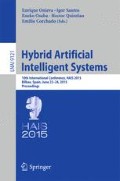Abstract
Over the last few years, computers and smartphones have become essential tools in our ways of communicating with each-other. Nowadays, the amount of applications in the Google store has grown exponentially, therefore, malware developers have introduced malicious applications in that market. The Android system uses the Dalvik virtual machine. Through reverse engineering, we may be able to get the different opcodes for each application. For this reason, in this paper an approach to detect malware on Android is presented, by using the techniques of reverse engineering and putting an emphasis on operational codes used for these applications. After obtaining these opcodes, machine learning techniques are used to classify apps.
Access this chapter
Tax calculation will be finalised at checkout
Purchases are for personal use only
Notes
- 1.
- 2.
Weka: Data Mining Software is a collection of machine learning algorithms for automated data mining tasks: http://www.cs.waikato.ac.nz/ml/weka/.
- 3.
- 4.
- 5.
- 6.
- 7.
Adware is a type of action hidden in applications, which send targeted advertisements to our device when you run an application.
References
Waters, D.: Google bets on Android future, February 2008. http://news.bbc.co.uk/2/hi/technology/7266201.stm
Enck, W., Octeau, D., McDaniel, P., Chaudhuri, S.: A study of android application security. In: USENIX Security Symposium (2011)
Fragkaki, E., Bauer, L., Jia, L., Swasey, D.: Modeling and enhancing android’s permission system. In: Foresti, S., Yung, M., Martinelli, F. (eds.) ESORICS 2012. LNCS, vol. 7459, pp. 1–18. Springer, Heidelberg (2012)
Sanz, B., Santos, I., Laorden, C., Ugarte-Pedrero, X., Bringas, P.G., Álvarez, G.: PUMA: permission usage to detect malware in android. In: Herrero, Á., et al. (eds.) Int. Joint Conf. CISIS 2012-ICEUTE 2012-SOCO 2012. AISC, vol. 189, pp. 289–298. Springer, Heidelberg (2013)
Shin, W., Kiyomoto, S., Fukushima, K., Tanaka, T.: Towards formal analysis of the permission-based security model for android. In: Fifth International Conference on Wireless and Mobile Communications, ICWMC 2009, pp. 87–92. IEEE (2009)
Shin, W., Kiyomoto, S., Fukushima, K., Tanaka, T.: A formal model to analyze the permission authorization and enforcement in the android framework. In: 2010 IEEE Second International Conference on Social Computing (SocialCom), pp. 944–951. IEEE (2010)
Jacoby, G.A., Davis IV, N.J.: Battery-based intrusion detection. In: Global Telecommunications Conference, GLOBECOM 2004, vol. 4, pp. 2250–2255. IEEE (2004)
Buennemeyer, T.K., Nelson, T.M., Clagett, L.M., Dunning, J.P., Marchany, R.C., Tront, J.G.: Mobile device profiling and intrusion detection using smart batteries. In: Proceedings of the 41st Annual Hawaii International Conference on System Sciences, pp. 296–296. IEEE (2008)
Schmidt, A.D., Bye, R., Schmidt, H.G., Clausen, J., Kiraz, O., Yuksel, K.A., Camtepe, S.A., Albayrak, S.: Static analysis of executables for collaborative malware detection on android. In: IEEE International Conference on Communications, ICC 2009. pp. 1–5. IEEE (2009)
Shabtai, A., Fledel, Y., Elovici, Y.: Automated static code analysis for classifying android applications using machine learning. In: 2010 International Conference on Computational Intelligence and Security (CIS), pp. 329–333. IEEE (2010)
Zhou, W., Zhou, Y., Jiang, X., Ning, P.: Detecting repackaged smartphone applications in third-party android marketplaces. In: Proceedings of the Second ACM Conference on Data and Application Security and Privacy, pp. 317–326. ACM (2012)
Santos, I., Brezo, F., Sanz, B., Laorden, C., Bringas, P.G.: Using opcode sequences in single-class learning to detect unknown malware. IET Inf. Secur. 5(4), 220–227 (2011)
Zhou, Y., Jiang, X.: Dissecting android malware: characterization and evolution. In: 2012 IEEE Symposium on Security and Privacy (SP), pp. 95–109. IEEE (2012)
Singh, Y., Kaur, A., Malhotra, R.: Comparative analysis of regression and machine learning methods for predicting fault proneness models. Int. J. Comput. Appl. Technol. 35(2), 183–193 (2009)
Breiman, L.: Random forests. Mach. Learn. 45, 5–32 (2001). doi:10.1023/A:1010933404324
Quinlan, J.: C4. 5: Programs for Machine Learning. Morgan kaufmann, San Francisco (1993)
Salzberg, S.L.: C4.5: Programs for machine learning by J. Ross Quinlan. Morgan Kaufmann Publishers, Inc., 1993. Mach. Learn. 16, 235–240 (1994). doi:10.1007/BF00993309
Jiang, L., Wang, D., Cai, Z., Yan, X.: Survey of improving Naive Bayes for classification. In: Alhajj, R., Gao, H., Li, X., Li, J., Zaïane, O.R. (eds.) ADMA 2007. LNCS (LNAI), vol. 4632, pp. 134–145. Springer, Heidelberg (2007)
Platt, J.C.: Sequential minimal optimization: a fast algorithm for training support vector machines (1998)
Author information
Authors and Affiliations
Corresponding author
Editor information
Editors and Affiliations
Rights and permissions
Copyright information
© 2015 Springer International Publishing Switzerland
About this paper
Cite this paper
de la Puerta, J.G., Sanz, B., Santos, I., Bringas, P.G. (2015). Using Dalvik Opcodes for Malware Detection on Android. In: Onieva, E., Santos, I., Osaba, E., Quintián, H., Corchado, E. (eds) Hybrid Artificial Intelligent Systems. HAIS 2015. Lecture Notes in Computer Science(), vol 9121. Springer, Cham. https://doi.org/10.1007/978-3-319-19644-2_35
Download citation
DOI: https://doi.org/10.1007/978-3-319-19644-2_35
Published:
Publisher Name: Springer, Cham
Print ISBN: 978-3-319-19643-5
Online ISBN: 978-3-319-19644-2
eBook Packages: Computer ScienceComputer Science (R0)

